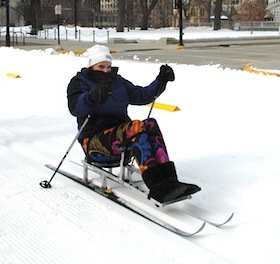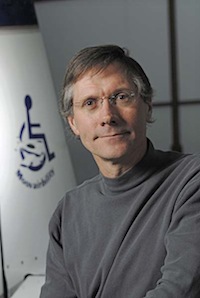Adaptive ski project gives people with disabilities a new chance to participate
Back in 2005, “sit-skis” for cross-country skiers with disabilities were expensive, uncomfortable and largely unavailable — except to a handful of Paralympic athletes, at price tags of more than $2,000.
Today, more than 300 sitting-position skis, with an adaptable, user-friendly design, enable a much wider group of people with lower-body limitations to participate in the popular winter sport, at a cost of only about $250 per ski.

Jane Schmieding demonstrates the “sit-ski” over trucked-in snow during WinterFest on Madison’s Capitol Square Feb. 17.
Photo: Christie Taylor
It all began nearly 10 years ago in Madison, when disability rights attorney Don Becker approached UW–Madison Mechanical Engineering Professor Jay Martin, an assistive technology expert, about designing a more user-friendly ski. His goal: make affordable sit-skis and distribute them based on need, allowing communities to develop programs that enable casual users — or kids — to more easily experiment with a new activity.
Martin incorporated Becker’s request as a project for engineering students in his assistive and rehabilitation technology design course. The first ski was born as a wood prototype in his own garage. “We tried to create a system that could be really quickly reconfigured to be adaptable to anyone’s body,” Martin says.
Building the next 10 skis from the students’ plans was a three-month community project. H&H Industries owner Chip Plummer donated the use of his sheet metal shop on weekends and helped acquire materials. Sit-ski users and others helped assemble the skis, which originally required no welding. Later, Isthmus Engineering offered discounted materials and space for mass-producing more than 200 skis. It was, and continues to be, a massive community effort, Becker says.
Now, many of the skis reside at state and city parks, where visitors can borrow them, or in adaptive exercise programs, which teach beginners how to sit-ski, using upper-body strength alone to propel themselves.
Betty Merten has spent her entire 56 years of life in a wheelchair because of spina bifida. She used to hate winter, a time when her manual wheelchair easily gets stuck in snow and ice. Yet, she happened to be a participant in the UW–Madison adaptive exercise class that tested the new skis, and she decided — before ever having skied on snow — to join a new sit-ski portion of the prestigious American Birkebeiner cross-country ski race in Hayward, Wis., in 2009.

Martin
At the very worst, Merten decided to train for the race and back out if she didn’t feel ready. “Little did I know having this kind of challenge can be life-changing,” she says. “I fell in love with the feeling of freedom. Skiing gives you a feeling of connectedness. It gets you outside, and it’s just fun.”
Since her first Birkie, Merten has participated every year. She’s also tried more new activities and is proud of her own transformation from being very out of shape to swimming a mile without stopping to completing a sprint triathlon and several 5K races. “I’ve ended up doing a lot of things I never thought I’d be able to do,” she says.
Another early sit-ski user was 62-year-old Jane Schmieding, who was just learning to cross-country ski when she developed multiple sclerosis in 1978. She now must stay active to maintain her upper-body strength. “Exercise is part of what I really feel I have to do to feel decent,” she says.
When there’s snow on the ground, Schmieding likes use her sit-ski, given to her by the program, at Governor Nelson State Park, alongside her husband. Like Merten, she’s skied in the Birkie since 2009 and also takes advantage of the Madison WinterFest each February to ski on trucked-in snow around the Capitol Square.
Schmieding also was among the group that helped assemble the first generation of sit-skis. Now, she tests new models, coordinates lessons for new sit-skiers, and volunteers and spectates at nearby adaptive ski events. “These athletes are so good,” she says. “The power of those people is just amazing.”
Previously more interested in issues like safety for assistive technology, Martin says he’s come to appreciate the huge impact recreation can have on people’s lives. “I saw how people reacted to the skis and how much everyone enjoyed this process,” he says.
“Assistive technology needs to be involved in all aspects of the human endeavor. A success on a sit-ski might lead someone to additional participation, which is one of the goals of what we do,” Martin says. “We want to produce technology that will allow people to make independent choices, and that means they should be able to participate when they want to.”
Tags: disabilities, engineering, recreation, winter




